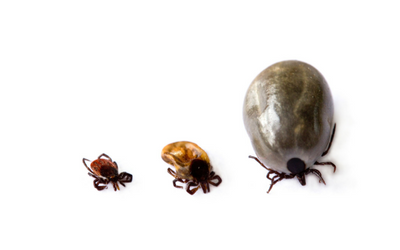
As spring approaches, we are all happy to get outside and enjoy the great outdoors. But, as the temperature warms and the snow begins to melt, ticks become active. Learn about ticks and what you can do to prevent ticks from becoming a “hitchhiker” on your pet.
What you need to know:
- Ticks DO NOT die in the winter. They overwinter under the snow where the temperature is warmer than the air temperature, and can survive very cold temperatures down to -4°F (-20°C).
- As soon as temperatures hit 39°F (4°C) ticks become active and begin looking for a meal.
- Ticks cannot fly or jump. They wait on tips of grass, shrubs, and leaf litter where they sense vibrations, odors, changes in temperature, and light patterns that occur when an animal (including people) walk past. The tick then extends its legs and grabs on to the passing animal.
- They live mostly in wooded areas, but can also be found in cities because they “hitch” rides on birds, mice and deer.
- There are over 15 species of ticks in North America. The most common are the American Dog Tick, the Deer Tick (also known as the Blacklegged Tick), the Brown Dog Tick, and the Lone Star Tick.
- Some ticks can transmit serious and deadly illnesses (e.g., the Blacklegged Tick can transmit Lyme disease).
- Blacklegged Ticks are expanding their range from year to year. Just because your area did not have ticks last year does not mean that it won’t this year.
- Ticks can be found in every state in the United States and in many areas of Canada.
- Ticks can conserve water and survive droughts – a hot dry summer does not mean there will be less ticks around.
What you can do:
- Start prevention BEFORE your pets are exposed. Ask your veterinarian about tick preventives. Your veterinarian will help you choose the best product(s) for your pet depending on where you live.
- Ask your veterinarian about the Lyme disease vaccine for dogs to see if it is available or recommended for your dog.
- Check your pets for ticks on a daily basis. If you find a tick, remove it following the directions below or see your veterinarian if you need help removing a tick. Check yourself too!
- If you see signs of Lyme disease in your cat (pain, stiffness in limbs, lameness, fever, loss of appetite, fatigue, sudden, collapse, trance-like behavior) or your dog (arthritis or sudden lameness, pain, fever, lack of appetite, dehydration, lack of activity, swollen lymph nodes and joints) contact your veterinarian.
- Do NOT use home remedies to remove ticks such as applying petroleum jelly or touching the rear of the tick with a match. These methods can cause the tick to salivate and actually increases the chance of transmitting disease to your pet.
- Clean up areas of your yard that make good tick habitat. Rake leaves, keep grass short, clean up areas beneath trees and hedges.
How to remove a tick
You will need:
- Fine-tipped tweezers
- Disposable gloves
- Soap and water
- Small container, rubbing alcohol, and marker
- Put on your gloves: It is recommended to wear disposable gloves, as in rare cases, infectious bacteria may be passed through breaks in the skin simply by handling infected ticks.
- Grasp close to the skin: Use the fine-tipped tweezers to grasp the tick as close to your pet’s skin as possible without pinching your pet’s skin. DO NOT TWIST OR JERK THE TICK. This may cause the mouthparts of the tick to break off and remain in your pet’s skin, which will increase the chance of infection.
- Pull Slowly: Pull the tick slowly and gently using steady, firm pressure. It may take several seconds for the tick to come out.
- Wash the bite area with soap and water to disinfect it after the tick has been removed. You can also apply an antibiotic ointment (e.g., Polysporin) to the area. Do not forget to wash your own hands.
- Monitor the bite site for signs of infection such as redness, inflammation, swelling or pus. Contact your veterinarian if you have any concerns.
- Place the tick in a small container with rubbing alcohol and bring it to your veterinarian to test it for disease. Label the container with information about the time and place where the tick bite occurred.